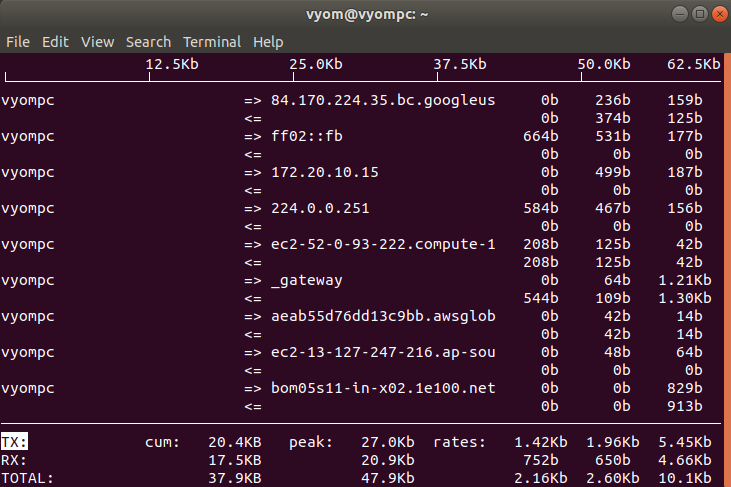Check Network Usage Per Process in Linux
Introduction
Monitoring and troubleshooting network connections is a routine task of any network administrator. Slow network connections may lead to huge downtime. So as a network administrator, you should always keep an eye on your network to understand and resolve whatever is causing network slowness. There are plenty of free tools available to monitor the network usage per process.
This post will show you different tools for monitoring network usage per process in Linux.
iftop
iftop is a simple, lightweight, and command-line network bandwidth monitoring tool. It allows us to get a quick overview of network activities on a specific interface.
For Ubuntu and Debian based distributions, you can install it using the following command:
apt-get install iftop -yFor RHEL, Fedora, and CentOS distributions, you can install it using the following command:
yum install iftop -yAfter the installation, open your terminal interface and run it using the following command:
iftopThis will display network usage bandwidth updates every 2, 10, and 40 seconds:

nload
nload is a powerful tool for monitoring network traffic and bandwidth usage in real-time. It monitors and displays inbound and outbound traffic via graph. It also shows the total amount of transferred data and min/max network usage.
For Ubuntu and Debian based distributions, you can install it using the following command:
apt-get install nload -yFor RHEL, Fedora, and CentOS distributions, you can install it using the following command:
yum install nload -yAfter the installation, open your terminal interface and run it using the following command:
nloadYou should see the following screen:

vnStat
vnStat is a full-featured and console-based network traffic monitoring tool. It is beneficial because it will keep a log of hourly, daily, and monthly network traffic. This will help you to analyze network traffic logs after the system reboot.
For Ubuntu and Debian based distributions, you can install it using the following command:
apt-get install vnstat -yFor RHEL, Fedora, and CentOS distributions, you can install it using the following command:
yum install epel-release -yyum install vnstat -yAfter the installation, you can launch it using the following command:
vnstat -l -i interface-nameThis will start monitoring network bandwidth in real-time:

NetHogs
NetHogs is a text-based network traffic monitoring tool that displays bandwidth usage by each process or application running on a Linux system. It is very useful in the event of a sudden bandwidth spike. NetHogs shows the most intensive processes on top. It reports the PID, user, and the path of the program.
For Ubuntu and Debian based distributions, you can install it using the following command:
apt-get install nethogs -yFor RHEL, Fedora and CentOS distributions, you can install it using the following command:
yum install epel-release -yyum install nethogs -yAfter the installation, run the NetHogs as shown below:
nethogsYou should see the following screen:

IPTraf
IPTraf is a powerful and ncurses-based command-line tool that can track both incoming and outgoing network traffic. It helps you track the network traffic data coming from potentially unlimited network devices. It supports both IPv4 and IPv6 connections and can monitor unlimited devices per network.
For Ubuntu and Debian based distributions, you can install it using the following command:
apt-get install iptraf -yFor RHEL, Fedora, and CentOS distributions, you can install it using the following command:
yum install epel-release -yyum install iptraf -yAfter the installation, open your terminal interface and launch it using the following command:
iptraf-ngYou should see the following screen:

bmon
bmon is an open-source monitoring and debugging tool to monitor bandwidth and capture networking-related statistics. It captures networking-related statistics and displays them visually in a human-friendly format.
For Ubuntu and Debian based distributions, you can install it using the following command:
apt-get install bmon -yFor RHEL, Fedora, and CentOS distributions, you can install it using the following command:
yum install epel-release -yyum install bmon -yAfter the installation, you can launch it using the following command:
bmonThis will start monitoring your network bandwidth usage:

Conclusion
I showed you the best network bandwidth monitoring tools for Linux in the above guide. I hope this will help you pick the best network usage tracking utility for your server.
Thank you for helping us improve!
